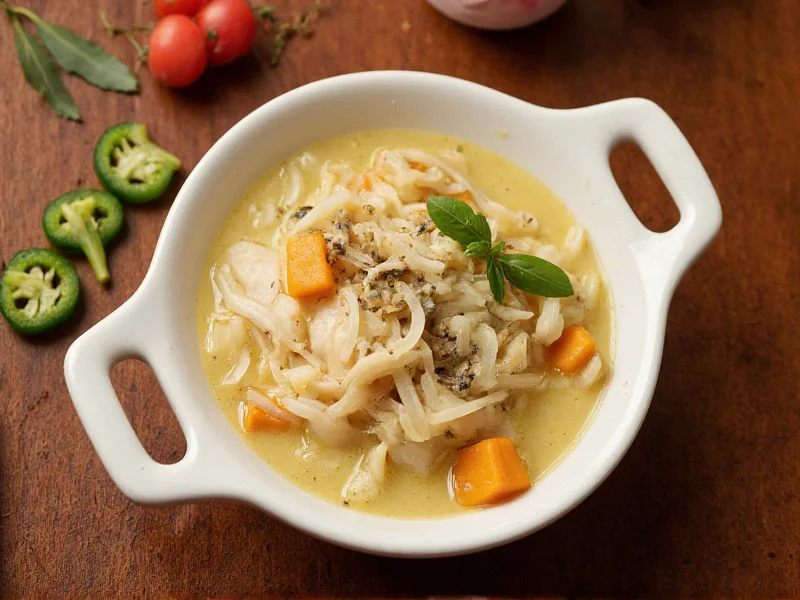Cod fish soup represents one of the world's most enduring seafood traditions, with roots stretching across coastal communities from Portugal to Norway. This versatile dish transforms simple, affordable ingredients into a nourishing meal that showcases the delicate flavor of cod without overpowering its natural taste. Unlike heavier chowders, authentic cod fish soup maintains a light broth consistency that highlights the fish's subtle sweetness while delivering essential omega-3 fatty acids and high-quality protein.
The Essential Components of Authentic Cod Fish Soup
Creating exceptional cod fish soup requires understanding which elements contribute most to its distinctive character. The foundation begins with selecting the right fish variety—Atlantic cod remains the traditional choice for its firm texture and mild flavor that absorbs surrounding aromatics beautifully. Many home cooks mistakenly use frozen cod without proper thawing techniques, which leads to mushy results. For optimal texture, thaw cod fillets overnight in the refrigerator rather than using microwave methods.
Vegetable selection proves equally critical in how to make cod fish soup from scratch. Traditional recipes incorporate a soffritto base of onions, carrots, and celery, while Scandinavian variations often feature dill and potatoes. The cooking liquid typically consists of fish stock enhanced with white wine, though water with fish bones works for those seeking an easy cod fish soup recipe without specialty ingredients. Acidic components like lemon juice or tomatoes added at the end brighten the flavors without cooking the delicate fish proteins.
Step-by-Step Preparation Guide
Follow these professional techniques for restaurant-quality results at home:
- Prepare ingredients: Cut 1.5 lbs cod into 1.5-inch chunks, dice 1 onion, 2 carrots, and 2 celery stalks uniformly
- Sauté aromatics: Cook vegetables in 2 tbsp olive oil over medium heat until translucent (8-10 minutes)
- Build broth: Add 4 cups fish stock, 1 diced tomato, and 1 bay leaf; simmer 15 minutes
- Add cod: Gently submerge fish pieces; cook 7-8 minutes until opaque but still moist
- Finish: Remove from heat; stir in 2 tbsp lemon juice and fresh parsley
Timing proves crucial in cod fish soup cooking time—overcooking by even two minutes turns tender cod rubbery. The ideal temperature range for cod is 130-140°F (54-60°C), well below boiling. Many traditional Portuguese authentic cod fish soup recipes incorporate chickpeas for added texture and protein, while Norwegian versions often include a splash of aquavit for complexity.
| Ingredient | Traditional Amount | Substitution Options |
|---|---|---|
| Fresh cod fillets | 1.5 lbs | Haddock, pollock |
| Yellow onions | 1 medium | Shallots, leeks |
| Carrots | 2 medium | Parsnips |
| Fish stock | 4 cups | Vegetable stock + 1 tsp fish sauce |
Nutritional Benefits and Dietary Considerations
Healthy cod fish soup nutrition makes it an excellent choice for balanced diets. A standard serving (1.5 cups) typically contains:
- 220-250 calories
- 28-32g high-quality protein
- 1.5g omega-3 fatty acids
- Significant vitamin B12, selenium, and phosphorus
Unlike cream-based seafood soups, traditional cod fish soup remains naturally low in saturated fat while providing complete protein. The inclusion of vegetables boosts fiber content and adds vitamins A and C. For those following creamy cod fish soup variations, adding a small amount of light coconut milk maintains lower calorie counts compared to dairy cream. Individuals monitoring sodium intake should use low-sodium stock and finish with fresh lemon juice for brightness instead of additional salt.
Regional Variations Worth Exploring
Cod fish soup demonstrates remarkable adaptability across culinary traditions. The Portuguese Caldeirada de Bacalhau incorporates bell peppers and olives, creating a stew-like consistency. Norwegian Bacalao features a tomato base with generous dill, while New England versions often include potatoes and corn for heartier texture. For an authentic Norwegian cod fish soup recipe, try adding a few drops of aquavit after cooking to enhance the oceanic notes without overpowering the delicate fish.
When preparing traditional cod fish soup ingredients, remember that regional authenticity matters less than respecting the fish's delicate nature. Many modern interpretations incorporate unexpected elements like saffron or smoked paprika, but purists argue these overwhelm cod's subtle flavor. The best approach balances tradition with personal taste preferences while maintaining the soup's fundamental lightness.
Expert Tips for Perfect Results Every Time
Professional chefs emphasize several often-overlooked techniques for superior cod fish soup:
- Temperature control: Keep broth at a gentle simmer (180-190°F/82-88°C), never boiling
- Layering flavors: Add hard vegetables first, delicate herbs at the end
- Fish addition timing: Wait until other ingredients are fully cooked before adding cod
- Acid balance: Introduce lemon juice or vinegar off-heat to preserve brightness
- Resting period: Let soup sit 5 minutes after cooking for flavors to meld
Avoid common mistakes like overcrowding the pot with too much fish at once or stirring vigorously after adding the cod. For those exploring best cod fish for soup recipes, remember that thicker fillets like cod loin withstand cooking better than thin tail pieces. Frozen cod works acceptably when thawed properly, but never cook directly from frozen as this guarantees uneven texture.











 浙公网安备
33010002000092号
浙公网安备
33010002000092号 浙B2-20120091-4
浙B2-20120091-4